
The Carpathian Mountains or Carpathians are a range of mountains forming an arc across Central Europe. Roughly 1,500 km (930 mi) long, it is the third-longest European mountain range after the Urals at 2,500 km (1,600 mi) and the Scandinavian Mountains at 1,700 km (1,100 mi). The range stretches from the far eastern Czech Republic (3%) and Austria (1%) in the northwest through Slovakia (21%), Poland (10%), Ukraine (10%), Romania (50%) to Serbia (5%) in the south. The highest range within the Carpathians is known as the Tatra mountains in Slovakia, where the highest peaks exceed 2,600 m (8,500 ft). The second-highest range is the Southern Carpathians in Romania, where the highest peaks range between 2,500 m (8,200 ft) and 2,550 m (8,370 ft).

A mountain pass is a navigable route through a mountain range or over a ridge. Since mountain ranges can present formidable barriers to travel, passes have played a key role in trade, war, and both human and animal migration throughout history. At lower elevations it may be called a hill pass. A mountain pass is typically formed between two volcanic peaks or created by erosion from water or wind.
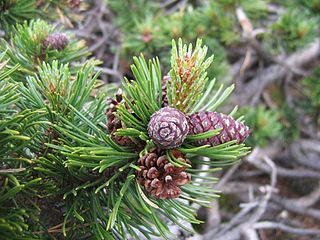
Pinus mugo, known as dwarf mountain pine, mountain pine, scrub mountain pine, Swiss mountain pine, bog pine, creeping pine, or mugo pine, is a species of conifer, native to high elevation habitats from southwestern to Central Europe and Southeast Europe.

Europe is traditionally defined as one of seven continents. Physiographically, it is the northwestern peninsula of the larger landmass known as Eurasia ; Asia occupies the centre and east of this continuous landmass. Europe's eastern frontier is usually delineated by the Ural Mountains in Russia, which is the largest country by land area in the continent. The southeast boundary with Asia is not universally defined, but the modern definition is generally the Ural River or, less commonly, the Emba River. The boundary continues to the Caspian Sea, the crest of the Caucasus Mountains, and on to the Black Sea. The Bosporus, the Sea of Marmara, and the Dardanelles conclude the Asian boundary. The Mediterranean Sea to the south separates Europe from Africa. The western boundary is the Atlantic Ocean. Iceland is usually included in Europe because it is over twice as close to mainland Europe as mainland North America. There is ongoing debate on where the geographical centre of Europe falls.
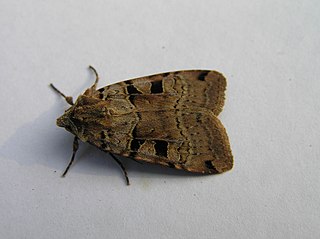
The double square-spot is a moth of the family Noctuidae. It is distributed through most of Europe except Portugal, the Mediterranean islands and northernmost Fennoscandia. In the East, the species ranges East across the Palearctic to Siberia and in the South-East to the Black Sea and in Iran. It rises to a height of about 2,000 metres (6,600 ft) in the Alps.

Ashworth's rustic is a species of moth. Its colouring is blue/grey and it is mainly nocturnal.

Xestia is a genus of noctuid moths. They are the type genus of the tribe Xestiini in subfamily Noctuinae, though some authors merge this tribe with the Noctuini. Species in this genus are commonly known as "clays", "darts" or "rustics", but such names are commonplace among Noctuidae. Xestia moths have a wide distribution, though they most prominently occur in the Holarctic.
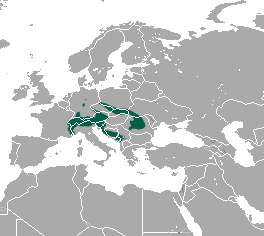
The alpine shrew is a species of mammal in the family Soricidae. It is found in the alpine meadows and coniferous forests of central and southern European mountain ranges.

Syngrapha ain is a moth of the family Noctuidae.
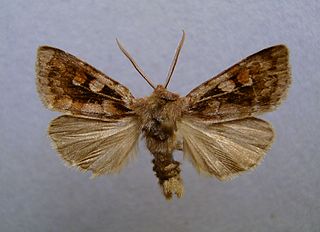
Xestia alpicola, the northern dart, is a moth of the family Noctuidae. It is found from northern Europe across the Palearctic to central Siberia and in the Alps.
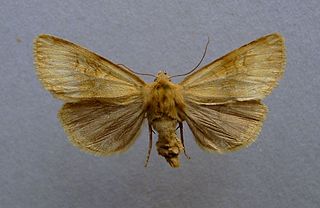
Xestia lorezi is a moth of the family Noctuidae. It is found in northern Europe and the Alps. Subspecies lorezi is found in the Alps on altitudes between 1,700 and 2,500 meters. Subspecies kongsvoldensis is found in Fennoscandia and northern Russia. Outside of Europe, there are four more subspecies, ssp. sajana in the Sayan Mountains, ssp. katuna in the Altai mountains, ssp. monotona in Yakutia and ssp. ogilviana in Yukon and Alaska.

Xestia speciosa is a moth of the family Noctuidae. It is found in northern Europe, including Fennoscandia, the Baltic region, parts of Russia and further through northern Asia to the Pacific Ocean and Japan. It is also found in the mountainous areas of central and southern Europe. It is also present in north-western North America.

Xestia collina is a moth of the family Noctuidae. It is found in the Alps, from southern France to southern Poland, Romania, from southern Finland and Estonia to the Urals, Siberia and northern Mongolia.

Xestia ochreago is a moth of the family Noctuidae.
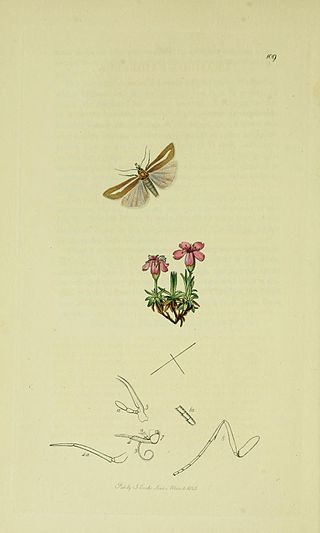
Catoptria furcatellus, the northern grass-veneer, is a moth of the family Crambidae described by Johan Wilhelm Zetterstedt in 1839. It is found in mountainous areas of Europe, including Fennoscandia, Wales, northern England, Scotland, the Alps and the Tatra Mountains.
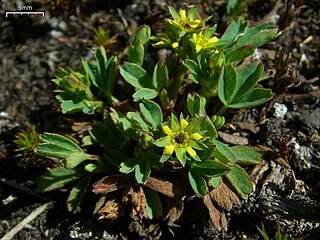
Sibbaldia procumbens is a species of flowering plant of the genus Sibbaldia in the rose family. It has an Arctic–alpine distribution; it can be found throughout the Arctic, as well as at higher elevations in the mountains of Eurasia and North America. It grows on tundra and in alpine climates where snow remains year-round, and on subalpine mountain slopes. This is a low, mat-forming perennial herb producing clumps of herbage in rocky, gravelly substrate. A spreading stem up to 15 centimeters long grows from a caudex. Each leaf is divided into usually three leaflets borne at the end of a petiole up to 7 centimeters long. Each wedge-shaped leaflet has three teeth at the tip. The flower has usually five pointed green bractlets, five wider pointed green sepals, and five tiny yellowish petals each about a millimeter long. The fruits develop in the remnants of the sepals on erect stalks.

Two-thousanders are mountains that have a height of at least 2,000 metres above sea level, but less than 3,000 metres. The term is used in Alpine circles, especially in Europe.

The Alps conifer and mixed forests is a temperate broadleaf and mixed forests ecoregion in central Europe. It extends along the Alps mountains through portions of France, Italy, Switzerland, Germany, Liechtenstein, Austria, and Slovenia. The ecoregion extends from the lower slopes of the Alps to its peaks, which include Mont Blanc, at 4,809 m (15,778 ft) the highest peak in the Alps.

Pinus × rhaetica, commonly known as Rhætic pine, the species name refers to the Rhætica alps, located in eastern Switzerland and western Austria. Rhaetic pine is described as a natural hybrid of Mountain pine and Scots pine. It is a coniferous tree nothospecies located in the subsection Pinus.
Rosa rhaetica, the Raetic rose, is a species of flowering plant in the family Rosaceae, native to the Alps of eastern Switzerland, western Austria, and northern Italy. A shrub with a very narrow distribution, it resembles Rosa dumalis and Rosa rubiginosa, but can be distinguished from them by careful examination of a suite of morphological traits.



















